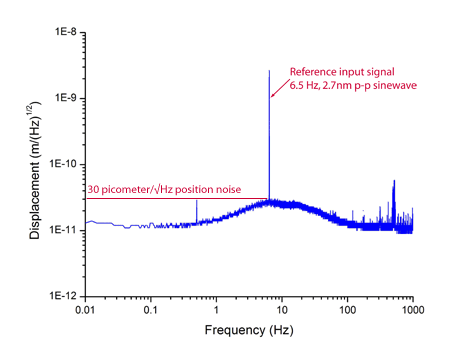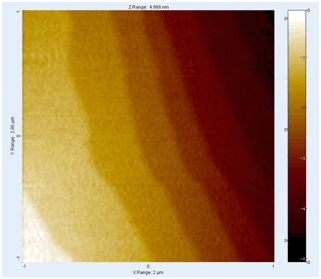

>>Ultra-Low Position Noise
Outstanding Accuracy
Extended Cable Lengths Without Performance Loss
No Performance Loss in Vacuum
Additional Information
Measuring Atomic Steps
Sub-Nanometer Motion
Measuring Surface Roughness
High Resolution Sensors
Nanopositioning Accuracy
Related Products
Nano-Bio Series
Questions?
E-Mail Us
Ultra-Low Position NoiseMad City Labs piezo nanopositioners include integrated, high-bandwidth, direct measurement position sensors with proprietary PicoQ® sensor technology, yielding unmatched precision and resolution capabilities due to the inherent low-noise properties of PicoQ® sensor technology. Piezo nanopositioners with PicoQ® sensor technology have lower position noise than capacitive sensor systems and exhibit better inherent long time-scale stability due to low 1/f noise. Capacitive sensor systems exhibit large 1/f noise at 10 Hz and below, resulting in long term position drift. The industry standard measurement of inherent position noise of piezo nanopositioners is position noise power spectrum analysis [MacKay, James F. Understanding noise at the nanometer scale. Laser Focus World, 43.3, (2007)]. When selecting a nanopositioning system, every customer should insist on seeing the position noise power spectrum of the piezo nanopositioner over the entire usable range of the device, typically 0.01 Hz to 1000 Hz.. The figures below demonstrate the noise power spectral density of Mad City Labs piezo nanositioners with PicoQ® sensor technology. Figure 1 shows that Mad City Labs long range piezo nanopositioning systems have a position noise floor in the tens of pm/√Hz. Note there is no rising 1/f noise at frequencies above 0.01 Hz.Sub-nanometer stability requires a low position noise floor, particularly for long time scale applications. Figure 2 shows the impressive position noise floor (400 fm/√Hz) on a shorter range nanopositioning system with PicoQ® sensor technology. For a spectactular demonstration of the relevance of position noise in nanopositioning, see the Mad City Labs AFM measurements of nanpositioning steps. |
|
AFM Verification of PicoQ® Sensor Technology PerformancePosition noise of a piezo nanopositioning system is the ultimate limit of the system's measurement resolution. Many applications involving sub-nanometer measurements, such as atomic force microscopy (AFM), would not be possible without low noise piezo nanopositioning systems. Some companies claim to sell systems with sub-nanometer resolution, but they do not have data from external metrology tests to support their claims. All Mad City Labs piezo nanopositioning products are rigorously tested before shipment. These tests involve a series of measurements designed to fully characterize the performance of the piezo nanopositioning system with a realistic environment and testing conditions that match the application. Available metrology tools include NIST-traceable interferometers, high resolution AFM, and a high resolution position noise analyzer, designed specifically for piezo nanopositioner characterization. The links below lead to in-depth descriptions of some of our AFM measurements.
Measurements taken with an AFM show that nanopositioners with PicoQ® sensor technology have sufficiently low position noise to accurately resolve single atomic layer size steps, 312 pm. AFM Demonstrations: Sub-Nanometer Motion 100 and 450 micron range nanopositioners with PicoQ® sensor technology perform 860 picometer steps, 1 nanometer sine wave, and repeated 95 picometer steps, externally measured by AFM. AFM Demonstrations: Measuring Surface Roughness AFM is used to externally verify that the position noise of a nanopositioning system with PicoQ® sensor technology is less than the surface roughness of a Si (111) sample, 60 pm RMS. |
Copyright © 2024


